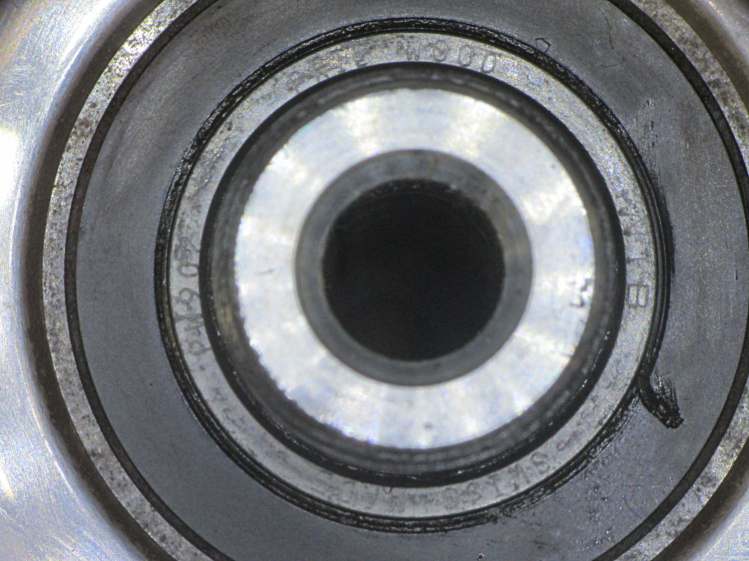Back in 2001, I specified Phil Wood hubs for our then-new Tour Easy recumbents, as I had absolutely no interest in fiddling with wheel bearings; been there, done that, it’s no fun at all.
Fast forward thirteen years, during which time I’ve done zero hub maintenance.
A few weeks ago, while backing my ‘bent out of the garage, the front wheel stopped rolling and skidded on the asphalt. Usually, that means a brake problem or something wedged between the wheel and the fender, but in this case, the axle itself jammed: the front bearings seized. I eased a bit of penetrating oil under the seals, the bearings began turning, and we continued the ride as planned.
A close look at the hub shows that, back in the day, Phil Wood used personalized bearings, made in Switzerland by WIB:

Phil Wood is still in business and a brief email exchange produced the proper bearing number: PWX92, at $17 each. I bought a pair to show my support. It turns out that the new bearings are from NSK and aren’t personalized.
The listing shows that the generic part number is 6902 and gives the dimensions:
- OD = 28 mm
- ID = 15 mm
- Width = 7 mm
I bought a lot of 10 6902RS2 deep-groove bearings from VXB for $35.90 delivered, so that I can compare their performance with The Real Thing.
Use a pair of 5 mm hex wrenches to remove one of the end caps, then gently tap the aluminum axle out of the hub:

The grease inside looks as good as the day they installed it: no water leaked through the seals or past the races.
Having a lathe ready to hand, I grabbed the axle in the chuck and unscrewed the other cap:

Everything came apart easily!
I applied grease everywhere, slid a new bearing and its wave washer into place on the axle, aligned it with the hub bore, and pushed it halfway into place.
Rather than beat on the bearings, I conjured a simple adapter that let me use the quick-release skewer as a press to persuade the outer race into the hub recess:

I stacked an old bearing between the skewer nut and the new bearing on the other side, with a fender washer to distribute the pressure on the old bearing. In general, you don’t want to press the bearings into place by applying pressure to the inner race, but in this case the pressure was so low that it probably didn’t matter.
With one bearing in place, remove the press, slide the second wave washer & bearing on the other end of the axle, install the press, push the bearing into place, tighten the end caps, and … it’s done!
Flushed with success, I repeated the operation on the front wheel of Mary’s bike. Those bearings felt better, but they turned with essentially no friction at all. That’s a sign the internal grease was pretty much gone and failure loomed over the horizon.
Cutting the seals out of the worst bearing from my bike showed water had gotten into the assembly:

This is not how a bearing should look:

The other bearing looked (and felt!) much better, but you always replace ’em in pairs.
Mary’s bike now has the new Phil Wood / NSK bearings, mine has the VXB bearings, and we’ll see what transpires. Both bikes sound much quieter, mine in particular, and I’m sure they roll better…
The rear tire on my bike needs replacing early this season, at which point I’ll dismantle the sprocket and install another two VXB bearings.

In the SF Bay Area, I had access to bearing/drive belt specialty shops. Locally, we have a few bearings at the farm suppliers, and I’ve seen the odd pillow block from the lone surviving mill supply outlet (not many mills left, though), but VXB has been my goto source for 10 years now. Recommended.
I never put a lot of miles on my Phil Wood hubs, but loved them. (I built those wheels to replace a set worn out on my old-school Rockhopper. It was set up for roads, and one crazy year I put 14K miles on it. Burned out badly, and cut my miles way down…)
You’re a better man than I, Gunga Din… whew!
It took too much time in my life to classify it as “better”, but it was fun, mostly. I participated in the “Century of the Month Club” on the usenet rec.bikes group back then. It also gave me an appreciation for ‘bents, at least from my back’s perspective.
Starting to see Tour Easys around Klamath Falls. No trikes yet.
There’s a guy hand-cranking a delta trike along the rail trail at a spectacular pace; the “pedals” run in phase, so he’s essentially rowing the thing.
I keep thinking that would be a great way to build upper body strength; it’d be a serious workout.